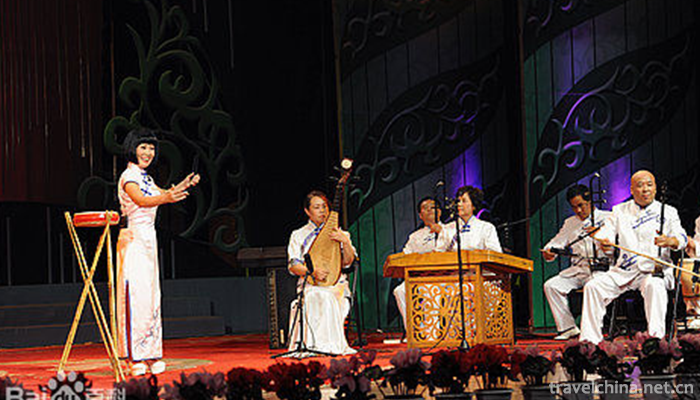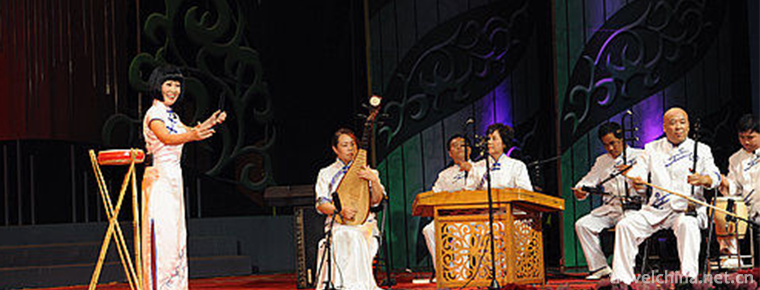Sanxianshu
Sanxianshu
Sanxianshu, also known as Qianzi Shu and Leg Blackboard Shu, is an ancient traditional rap art formed in Nanyang, Henan Province. It has a history of more than 250 years. It is named for its main accompaniment instrument, which is composed of three strings and Qianzi (small cymbal). It is one of the four major local songs. For the first time, it was a play for one person, with three strings in one's arms and legs (feet) playing and singing by oneself. Later, with the improvement of audiences'aesthetic requirements and the development of nature, Nanyang gradually evolved into a two-or-three-person opera with singers hitting hinges or octagonal drums to sing and watch, accompanied by three strings and falling Hu to help tune and interrupt in singing, which enabled the rap art to develop faster and spread more widely. Nanyang is the "hometown of opera art" named by the Chinese Opera Artists Association. Yangqu art is famous all over the country. The main types of Nanyang Quyi are major tunes and three-string books. Sanxianshu has important value and influence.
On June 7, 2008, Sanxianshu was approved by the State Council and listed in the second batch of national intangible cultural heritage list.
Introduction to Sanxian Books
Sanxianshu's singing style is simple and unadorned, lively in form, rich in local flavor, deeply loved by the people. It is a typical traditional rap art. It once ruled Nanyang opera circle, and has been passed on for more than 100 years. There are more than 400 songs in existence, including more than 200 passages, more than 100 book caps and 36 medium-length books. Their literary and musical artistic level is very high.
Tri-genre Style
The Three Emperors'Club
After the mid-Qing Dynasty, Sanxianshu was relatively prosperous. It mainly adopted the method of setting up "imperial society", also known as Huishu (equivalent to the present form of performance), namely "Sanhuangshu".
Sanxian calligraphers worship the three emperors (Mikado, Dihuang, Renhuang) as their ancestors. On the birthday of the three emperors, artists gather, set up shelters, burn incense to worship God and sing for three days. The conference is organized by old artists and invitations are sent to all "teams" and artists.
Invited persons should pay certain gifts to the Royal Society as expenditure funds. According to the level of artists, the imperial club will perform in "head shed", "two shed" and "three shed". It also employs famous artists and talent, as well as famous local gentry, to appraise the repertoire of the performances. These people also have division of labor. They have the purpose of specializing in music, singing music (including accompaniment), lyric and song combination and performance. They are called "social management", "editorial", "voice calling", "word listening" and so on. Being rated first class by the conference is equivalent to winning the "top prize" and giving awards, called "hanging red", the artists who hang red enjoy high honor in society and among artists. If the performance is not good, there will be penalties for different words, wrong words, off-board, barren tune and other situations. If you find that the lyrics are too elegant or crude, you will receive severe corrections.
Rules and regulations
In addition to artistic exchanges and mutual improvement among artists, the "Three Emperors'Club" also has the nature of close association.
In the county of Sanxianshu, a person in charge should be elected as "Tour 1000", and rules and regulations should be formulated to manage the performance discipline and style of artists. The Royal Council's statutes include: no sharp selling, no picking on other people's tea and meals, no abducting other "team" fellows, no abducting apprentices, no stealing other people's things, no turning back and forth of lies, etc. If a woman is found to be abducted, she shall cut her eyes and ears at the Royal assembly and be forbidden to perform in three-stringed books; if someone steals someone else, she shall be dismissed by the Royal Society by word of mouth, and her colleagues have met with the stringers; and if the disciples are abducted, they will beat five hundred willow sticks, etc. The "Three Emperors'Club" also requires three kinds of stability, i.e. eye stability, hand stability and mouth stability: eye stability means not looking at women in performance and life; hand stability means not taking other people's things; mouth stability means not speaking low-level obscene language. If offenders break strings and burn burdens. The regulations of the Three Royal Societies are very strict, which regulates the performance criteria of artists, corrects their moral character and promotes the development of the art of Sanxianshu. This rule continued until the eve of liberation.
Schools
As an art category, Sanxianshu has evolved into different genres in terms of performance techniques, use of tunes and singing characteristics due to the different dialects and folk customs, along with the deepening of understanding of tune, board road, mode and tonality in the long-term singing.
From 1930s to 1930s, Sanxianshu, which mainly distributes in the southwest of Henan Province, formed three major schools: the East Road School, the Middle Road School and the West Road School, each of which has its own singing style. Taking the Jinglou of Credit Banner Town, Mobi, Rao Liang, Tanghe River and the Anpeng area of Tongbai as the Eastern Road School, its representative figures are Zhang Yongxi, Anyusong, Wu Kaishan, etc. They are mainly high-chord singers with high-spirited style, strong momentum, and are good at Wushu and Zhengshu, with the beauty of masculinity. The Qiaotou in the west of Credit Banner is the central road school, and its representative figures are Liu Yongke, Wang Simazi and Kingdom. Dong et al. are mainly plain chord singers with soft and deep style, good at expressing feelings, and have three wonderful chants; Shiqiao and Fangcheng in Nanyang are the West Road School, whose representatives are Liu Literature, Lei Shengtang, Pei Xuede, Zhang Mingchuan, etc. They are mainly bass singers, whose style is solemn and delicate, melancholy and lingering. After a song, the remaining tones surround the beam.
Characteristic
The three schools have their own characteristics. However, due to the influence of geographical environment, language and sister songs, the Donglu School has a distinct difference from the Zhongxi Road, which has the charm of Hubei Yugu and Henan Southern Folk Songs. In a word, the formation and development of the three schools are the result of absorbing the folk songs, ballads and dialects from different regions, so they are more local and popular with the masses on one side.


-
1.Tong li ancient town
Tongli Ancient Town belongs to Wujiang District, Suzhou City, Jiangsu Province. It was built in Song Dynasty. There are many gardens, temples, residences
Time 2018-12-06 -
2.Huangguoshu Waterfalls Scenic Area
Huangguoshu Scenic Spot is a key national scenic spot, located in southwest Guizhou Province, 128 kilometers away from Guiyang City, the capital of Guizhou Province
Time 2018-12-12 -
3.Linzhi Basongcuo Scenic Area
Basongtao, also known as Caogao Lake, means "green water" in Tibetan. It is about 18 kilometers long. Its surface area is about 27 square kilometers.
Time 2018-12-12 -
4.Uruwati Scenic Area
Uruwati Scenic Area is located in the upper reaches of Karakash River at the southern foot of Kunlun Mountains and in the territory of Langruxiang, Hetian County.
Time 2018-12-22 -
5.Jining Beihu Tourist Resort
Jining is the world-famous town of Confucius and Mencius and the capital of the canal. Located 6 kilometers south of Jining City, Shandong Province, Beihu Lake is a new tourist attraction in Shandong
Time 2019-01-21 -
6.dongjing music
Dongjing music is a very ancient traditional instrumental music, which originated in Sichuan Province in the Song Dynasty and is now popular in Sichuan Province
Time 2019-04-28 -
7.Kazakh Karakol Leha
On May 23, 2011, Kazakh Karakol Kazakh was listed in the third batch of national intangible cultural heritage list with the approval of the State Council.
Time 2019-05-02 -
8.Brewing Techniques of Maotai Liquor
Maotai liquor brewing technology, the local traditional handicraft technology of Maotai Town, Zunyi City, Guizhou Province, is one of the national intangible cultural heritage.
Time 2019-05-29 -
9.Jumping vegetables of the Yi nationality
The dance accompaniment of the Yi nationality is "Dance dishes", which means serving dishes by dancing. It is a unique form of serving and the highest etiquette of banquet for Yi people in W
Time 2019-07-12 -
10.Acupuncture
Acupuncture means that under the guidance of traditional Chinese medicine theory, needles (usually filiform needles) are punctured into patients'bodies at a certain angle, and needling techniques such
Time 2019-07-25 -
11.Beijing University Of Chemical Technology
Founded in 1958, Beijing University of Chemical Technology, formerly known as Beijing Institute of Chemical Technology, is a high-level university founded by New China for "training advanced chem
Time 2019-09-06 -
12.Huang Daopo
Huang Daopo (1245 - 1330), also known as Huang Po , Yellow mother , Songjiang prefecture Wu Najing town (now Xuhui District, Shanghai) Huajing town People, famous at the end of Song Dynasty and early
Time 2019-09-07